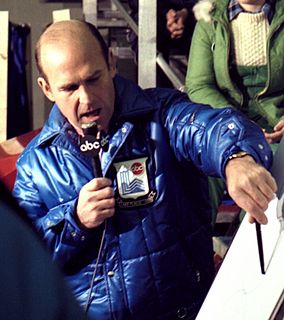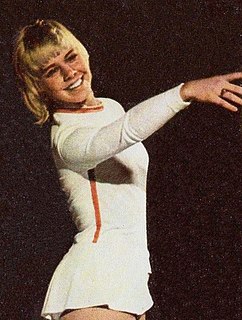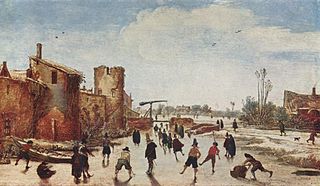
Figure skating is a sport in which individuals, duos, or groups perform on figure skates on ice. It was the first winter sport to be included in the Olympic Games, when contested at the 1908 Olympics in London. The four Olympic disciplines are men's singles, ladies' singles, pair skating, and ice dance; the non-Olympic disciplines include synchronized skating, Theater on Ice, and four skating. From intermediate through senior-level competition, skaters generally perform two programs, which, depending on the discipline, may include spins, jumps, moves in the field, lifts, throw jumps, death spirals, and other elements or moves.

The 1952 Winter Olympics, officially known as the VI Olympic Winter Games, took place in Oslo, Norway, from 14 to 25 February 1952.

Midori Ito or Midori Itō is a Japanese former figure skater. She is the 1989 World champion and the 1992 Olympic silver medalist. She is the first woman to land a triple-triple jump combination and a triple Axel in competition. At the 1988 Calgary Olympics, she became the first woman to land seven triple jumps in an Olympic free skating competition.

Richard Totten "Dick" Button is an American former figure skater and skating analyst. He is a two-time Olympic champion and five-time World champion (1948–1952). He is also the only non-European man to have become European champion. Button is credited as having been the first skater to successfully land the double axel jump in competition in 1948, as well as the first triple jump of any kind – a triple loop – in 1952. He also invented the flying camel spin, which was originally known as the "Button camel."
Figure skating at the 1948 Winter Olympics took place at the Olympic Ice Rink in St. Moritz, Switzerland. Three figure skating events were contested: men's singles, ladies' singles, and pair skating.

Figure skating at the 1928 Winter Olympics took place at the Olympic Ice Rink in St. Moritz, Switzerland, between 14 and 19 February 1928. Three figure skating events were contested: men's singles, ladies' singles, and pair skating.
The 1952 Winter Olympics, officially known as the VI Olympic Winter Games, took place in Oslo, Norway, from 14 to 25 February 1952. A total of 694 athletes representing 30 National Olympic Committees (NOCs) participated in the Games, taking part in 22 events from 6 sports.

The figure skating events in 1998 Winter Olympics were held at the White Ring in Nagano. There were no changes in the format or scoring systems from 1994. Professionals were again allowed to compete, although they had to declare that intention and compete in ISU-approved events to do so. Most of the top competitors by 1998 were now openly professional.

Janet Lynn Nowicki is an American figure skater. She is the 1972 Olympic bronze medalist, a two-time world championships medalist, and a five-time U.S. national champion.
The figure skating events at the 1972 Winter Olympics were held at the Makomanai Skating Rink and the Mikaho Indoor Skating Rink.

Yuna Kim, also credited in eastern name order as Kim Yuna or Kim Yeon-ah, is a South Korean former competitive figure skater. She is the 2010 Olympic champion and 2014 silver medalist in ladies' singles; the 2009 & 2013 World champion; the 2009 Four Continents champion; a three-time Grand Prix Final champion; the 2006 World Junior champion; the 2005 Junior Grand Prix Final champion; and a six-time South Korean national champion.
Figure skating is a sport with participants across the world. Originally based in North America and Europe, the sport has experienced a major expansion in the countries of East Asia.

The history of figure skating stretches back to prehistoric times. Primitive ice skates appear in the archaeological record from about 3000 BC. Edges were added by the Dutch in the 13th - 14th century. International figure skating competitions began appearing in the late 19th century—in 1891, the European Championships were inaugurated in Hamburg, Germany, and in 1896, the first World Championship were held in Saint Petersburg, Russian Empire. At the 1908 Summer Olympics in London, England, figure skating became the first winter sport to be included in the Olympics.

Single skating is a discipline of figure skating in which male and female skaters compete individually. Men's singles and women's singles, along with the other figure skating disciplines of pair skating, ice dance, and synchronized skating, are governed by the International Skating Union (ISU). Figure skating is the oldest winter sport contested at the Olympics, with men's and women's single skating appearing as two of the four figure skating events at the London Games in 1908.

The short program of figure skating is the first of two segments of competitions, skated before the free skating program. It lasts, for both senior and junior singles and pair skaters, 2 minutes and 40 seconds. In synchronized skating, for both juniors and seniors, the short program lasts 2 minutes and 50 seconds. Vocal music with lyrics is allowed for all disciplines since the 2014-2015 season. The short program for single skaters and for pair skaters consists of seven required elements, and there are six required elements for synchronized skaters.
The 2009 Four Continents Figure Skating Championships an international figure skating competition in the 2008–09 season. It was held at the Pacific Coliseum in Vancouver, Canada on February 2–8. Medals were awarded in the disciplines of men's singles, ladies' singles, pair skating, and ice dancing. The compulsory dance was the Finnstep.
Figure skating at the 2010 Winter Olympics was held at the Pacific Coliseum in Vancouver, British Columbia, Canada. The events took place between 14–27 February 2010.
The 1960 United States Figure Skating Championships was an event organized by U.S. Figure Skating to determine the U.S. national champions and the U.S. teams for the 1960 Winter Olympics and 1960 World Championships. Medals were awarded in three colors: gold (first), silver (second), and bronze (third) in four disciplines – men's singles, ladies' singles, pair skating, and ice dancing – across three levels: senior, junior, and novice. The event was held at the Civic Ice Arena in Seattle from January 27 through 30, 1960.
The 1965 United States Figure Skating Championships was an event organized by U.S. Figure Skating to determine the U.S. national champions and the U.S. team for the 1965 World Championships. Medals were awarded in three colors: gold (first), silver (second), and bronze (third) in four disciplines – men's singles, ladies' singles, pair skating, and ice dancing – across three levels: senior, junior, and novice. The event was held at the (1932) Olympic Arena in Lake Placid, New York, from February 10 to 13, 1965.
The men's figure skating competition at the 1952 Winter Olympics took place on 19 and 21 February at Jordal Amfi and Bislett stadion. The compulsory figures were held at Jordal Amfi, while the Free skating was contested at Bislett stadion. The ice surface at Bislett was set inside the oval created by the speed skating track. It was also an outdoor arena, which was used for the opening and closing ceremonies. There were no issues with the weather and the skating surface at Bislett was immaculate. Computers were used for the first time during the figure skating competitions to help tabulate the judges' marks and relay the results instantaneously.










